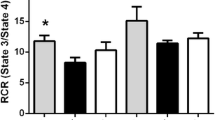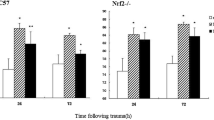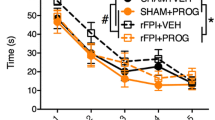Abstract
The gonadal hormone, progesterone, has been shown to have neuroprotective effects in injured nervous system, including the severity of postinjury cerebral edema. Progesterone’s attenuation of edema is accompanied by a sparing of neurons from secondary neuronal death and with improvements in cognitive outcome. In addition, we recently reported that postinjury blood-brain barrier (BBB) leakage, as measured by albumin immunostaining, was significantly lower in progesteronetreated than in nontreated rats, supporting a possible protective action of progesterone on the BBB. Because lipid membrane peroxidation is a major contributor to BBB breakdown, we hypothesized that progesterone limits this free radical-induced damage. An antioxidant action, neuroprotective in itself, would also account for progesterone’s effects on the BBB, edema, and cell survival after traumatic brain injury. To test progesterone’s possible antiperoxidation ef-fect, we compared brain levels of 8-isoprostaglandin F2α (8-isoPGF2α), a marker of lipid peroxidation, 24, 48, and 72 h after cortical contusion in male rats treated with either progesterone or the oil vehicle. The brains of progesteronetreated rats contained approximately one-third of the 8-isoPGF2α found in oil-treated rats. These data suggest progesterone has antioxidant effects and support its potential as a treatment for brain injury.
Similar content being viewed by others
References
Audrus K. L., Guillot F. L., and Braughler J. M. (1991) Evidence for 21-aminosteroid association with the hydrophilic domains of brain microvessel endothelial cells.Free Radical Biol Med. 11, 361–371.
Behl C., Widmann M., Trapp T. and Holsboer F. (1995) 17-beta estradiol protects neurons from oxidative stress-induced cell death in vitro.Biochem. Biophys. Res. Commun. 216, 473–482.
Belelli D., Bolger M. B. and Gee K. W. (1989) Anticonvulsant profile of the progesterone metabolite 5α-pregnane.-3α-ol-20-one.Eur. J. Pharm. 166, 325–329.
Betz A. L. and Coester H. C. (1990) Effects of steroids on edema and sodium uptake of the brain during focal ischemia in rats.Stroke 21(8), 199–204.
Betz A. L., Iannotti F., and Hoff J. T. (1989) Brain edema: A classification based on blood-brain barrier integrity.Cerebrovas. Brain Metab. Rev. 1, 133–154.
Braughler J. M. and Hall E. D. (1989) Central nervous system trauma and stroke. I. Biochemical considerations for oxygen radical formation and lipid peroxidation.Free Radical Biol. Med. 6, 289–301.
Braughler J. M., Pregenzer J. F. and Chase R. L. (1989) The 21-aminosteroids: Potent inhibitors of lipid peroxidation for the treatment of central nervous system trauma and ischemia.Drugs Future 14, 143–152.
Cervos-Navarro J. and Lafuente J. V. (1991) Traumatic brain injuries: structural changes.J. Neurol. Sci. 103, S3-S14.
Chan P. H., Longar S., and Fishman R. A. (1985) Oxygen, free radicals: potential edema mediators in brain injury, inBrain Edema, Springer-Verlag, Tokyo., pp. 317–323.
Demopoulos H. B., Flamm E. S., Pietronigro D. D. and Seligman M. L. (1980) The free radical pathology and the microcirculation in the major central nervous system disorders.Acta Physiol. Scand. 492 (Suppl), 91–119.
Demopoulos H. B., Flamm E. S., Seligman M. L., Pietronigro J., Tomasula J. and DeCrescito V. (1982) Further studies on free-radical pathology in the major central nervous system disorders: effect of very high doses of methylprednisolone on the functional outcome, morphology, and chemistry of experimental spinal cord impact injury.Can. J. Physiol. Pharm. 60, 1415–1424.
Duvdevani R., Roof R. L., Fulop Z., Hoffman S. W. and Stein D. G. (1995) Blood-brain barrier breakdown and edema formation following frontal cortical contusion—Does hormonal status play a role?J. Neurotrauma 12, 65–75.
Faden A. I., Demediuk P., Painter S. S., and Vink R. (1989) The role of excitatory amino acids and NMDA receptors in traumatic brain injury.Science 244, 798–800.
Frye C. A. (1995) The neurosteroid 3 alpha, 5 alpha-THP has antiseizure and possible neuroprotective effects in an animal model of epilepsy.Brain Res. 696, 1–2.
Gee K. W., Bolger M. B., Brinton R. E., Coirini H. and McEwen B. S. (1988) Steroid modulation of the chloride ionophore in rat brain: structure-activity requirements, regional dependence and mechanism of action.J. Pharmacol. Exp. Ther. 246, 803–812.
Goodman Y., Bruce A. J., Bin C. and Mattson M. P. (1996) Estrogens attenuate and corticosterone exacerbates excitotoxicity, oxidative injury, and amyloid β-peptide toxicity in hippocampal neurons.J. Neurochem. 66, 1836–1944.
Greenwood J. (1991) Mechanisms of blood-brain barrier breakdown.Neuroradiology 33, 95–100.
Hall E. D. (1985) High-dose glucocorticoid treatment improves neurological recovery in head-injured mice.J. Neurosurg. 62, 882–887.
Hall E. D. (1989) Free radicals and CNS injury.Crit. Care Clin. 5, 793–805.
Hall E. D. (1993) Lipid antioxidants in acute central nervous system injury.Ann. Emerg. Med. 22, 1022–1027.
Hall E. D. and Braughler J. M. (1989) Central nervous system trauma and stroke. II. Physiological and pharmacological evidence for involvement of oxygen radicals and lipid peroxidation.Free Radical Biol. Med. 6, 303–313.
Hall E. D. and Braughler J. M. (1993) Free radicals in CNS injury, inMolecular and Cellular Approaches to the Treatment of Neurological Disease, Raven, New York, pp. 81–105.
Hall E. D. and Travis M. A. (1988) Inhibition of arachidonic acid-induced vasogenic brain edema by the non-glucocorticoid 21-aminosteroid U74006F.Brain Res. 451, 350–352.
Hall E. D., Yonkers P. A., McCall J. M. and Braughler J. M. (1988) Effect of the 21-aminosteroid U-74006F on experimental head injury in mice.J. Neurosurg. 68, 456–461.
Hall E. D., Andrus P. K. and Yonkers P. A. (1993) Brain hydroxyl radical generation in acute experimental head injury.J. Neurochem. 60, 588–594.
Hall E. D., McCall J. M. and Means E. D. (1994) Therapeutic potential of the lazaroids (21-aminosteroids) in acute central nervous system trauma, ischemia and subarachnoid hemorrhage.Adv. Pharmacol. 28, 221–268.
Harrison N. L., Majewska M. D., Harrington J. W. and Barker J. L. (1987) Structureactivity relationship for steroid interaction with the gamma-aminobutyric acid-A receptor complex.J. Pharmacol. Exp. Ther. 241, 346–352.
Hoffman S. W., Roff R. L. and Stein D. G. (1996) A reliable and sensitive enzyme immunoassay method for measuring 8-isoprostaglandin F2α: A marker for lipid peroxidation after experimental brain injury.J. Neurosci. Methods 68, 133–136.
Hogskilde S., Wagner J., Carl P., Anker N., Angelo H. R. and Sorensen M. B. (1988) Anticonvulsant properties of pregnanolone emulsion compared with althesin and theipentone in mice.Br. J. Anesthesiol. 61, 462–467.
Kokate T. G., Svensson B. E. and Rogawski M. A. (1994) Anticonvulsant activity of neurosteroids: Correlation with γ-aminobutyric acid-evoked chloride current potentiation.J. Pharmacol. Exp. Ther. 270, 1223–1229.
Kontos H. A. and Povlishock J. T. (1986) Oxygen radicals in brain injury.CNS Trauma 3(4), 257–263.
Kontos H. A., Wei E. P., Povlishock J. T., Dietrich W. D., Magiera C. J. and Ellis E. F. (1980) Cerebral arteriolar damage by arachidonic acid and prostaglandin G2.Science 209, 1242–1244.
Kukreja R. C., Kontos H. A., Hess M. L. and Ellis E. F. (1986) PGH synthase and lipoxygenase generate superoxide in the presence of NADH and NADPH.Circ. Res. 59, 612–619.
Majewska M. D., Harrison N. L., Schwartz R. D., Barker J. L. and Paul S. M. (1986) Steroid hormone metabolites are barbiturate-like modulators of the GABA receptor.Science 232, 1004–1007.
McIntosh T. K. (1994) Neurochemical sequelae of traumatic brain injury: Therapeutic implications.Cerebrovasc. Brain Metab. Rev. 6, 109–162.
McIntosh T. K., Vink R., Soares H., Hayes R. and Simon R. (1990) Effects of noncompetitive blockade ofN-methyl-d-aspartate receptors on the neurochemical sequelae of experimental brain injury.J. Neurochem. 55, 1170–1179.
Morrow J., Hill K., Burk R., Nammour T., Badr K. and Roberts L. (1990) A series of prostaglandin F2-like compounds are produced in vivo in humans by a noncyclooxygenase, free radical-catalyzed mechanism.Proc. Natl. Acad. Sci. USA 87, 9383–9387.
Olson J. J., Poor M. M. and Beck D. W. (1988) Methylprednisolone reduces the bulk flow of water across an in-vitro blood-brain barrier.Brain Res. 439, 259–265.
Panter S. S. and Faden A. I. (1992) Pretreatment with NMDA antagonists limits release of excitatory amino acids following traumatic brain injury.Neurosci. Lett. 136, 165–168.
Roof R. L., Duvdevani R. and Stein D. G. (1992) Progesterone treatment attenuates brain edema following contusion injury in male and female rats.Restor. Neurol. Neurosci. 4, 425–427.
Roof R. L., Duvdevani R. and Stein D. G. (1993) Gender influences outcome of brain injury: Progesterone plays protective role.Brain Res. 607, 333–336.
Roof R. L., Braswell L. K., Duvdevani R. and Stein D. G. (1994) Progesterone facilitates cognitive recovery and reduces secondary neuronal loss following cortical contusion injury in male rats.Exp. Neurol. 129, 64–69.
Roof R. L., Duvdevani R., Heyburn J. W. and Stein D. G. (1996a) Progesterone rapidly decreases brain edema: Treatment delayed up to 24 hours is still effective.Exp. Neurol. 138, 246–251.
Roof R. L., Duvdevani R., Heyburn J. W. and Stein D. G. (1996b) Progesterone improves blood-brain barrier integrity after traumatic brain injury.J. Neurotrauma, submitted.
Seligman M. L., Mitamura L. J., Shera N. and Demopoulos H. B. (1979) Corticosteroid (methylprednisolone) modulation of photoperoxidation by UV light in Liposomes.Photochem. Photobiol. 29, 549–558.
Shimamura K., Sugino N., Yoshida Y., Nakamura Y., Ogino K. and Kato H. (1995) Changes in lipid peroxide and antioxidant enzyme activities in corpora lutea during pseudopregnancy in rats.J. Reprod. Fertil. 105, 253–257.
Smith S. S. (1991) Progesterone administration attenuates excitatory amino acid responses of cerebellar Purkinje cells.Neuroscience 42, 309–320.
Smith S. L., Adrus P. K., Zhang J.-R. and Hall E. D. (1994) Direct measurement of hydroxyl radicals, lipid peroxidation, and blood-brain barrier disruption following unilateral cortical impact head injury in the rat.J. Neurotrauma 11, 393–404.
Stein D. G. and Roof R. L. (1996) Mechanisms of injury and repair in traumatic brain injury inImaging in Neuroglic Rehabilitation. Demos Vermande, New York, pp. 79–90.
Stein D. G., Halks-Miller M., and Hoffman S. W. (1991) Intracerebral administration of Alpha-Tocopherol-containing liposomes facilitates behavioral recovery in rats with bilateral lesions of the frontal cortex.J. Neurotrauma 8(4), 281–292.
Wahl M., Schilling L., Unterberg A., and Baethmann A. (1993) Mediators of vascular and parenchymal mechanisms in secondary brain damage.Acta Neurochir. Suppl. (Wien) 57, 64–72.
Walsh S. W. (1994) Lipid peroxidation in pregnancy.Hypertens. Pregnancy 13(1), 1–32.
Wei E., Kontos H., Dietrich W., Povlishock J. and Ellis E. (1981) Inhibition by free radical scavengers and cyclooxygenase inhibitors of pial arteriolar abnormalities from concussive brain injury in cats.Circ. Res. 48, 95–103.
Whiting K. P., Brain P. F. and Restall C. J. (1995) Steroid hormone induced effects on membrane fluidity.Biochem Soc. Trans. 23, 4385.
Yonkers P. A., Hall E. D., Taylor B., Sun F. F., Guido D. M. and Mathews, W. R. (1993) Mechanism of action of methylprednisolone in acute spinal cord injury: inhibition of phospholipase A2 vs. inhibition of lipid peroxidation.J. Neurotrauma 10, S92.
Zuccarello M. and Anderson D. K. (1989) Protective effect of a 21-aminosteroid on the blood-brain barrier following subarachnoid hemorrhage in rats.Stroke 20, 367–371.
Author information
Authors and Affiliations
Rights and permissions
About this article
Cite this article
Roof, R.L., Hoffman, S.W. & Stein, D.G. Progesterone protects against lipid peroxidation following traumatic brain injury in rats. Molecular and Chemical Neuropathology 31, 1–11 (1997). https://doi.org/10.1007/BF02815156
Received:
Revised:
Accepted:
Issue Date:
DOI: https://doi.org/10.1007/BF02815156




